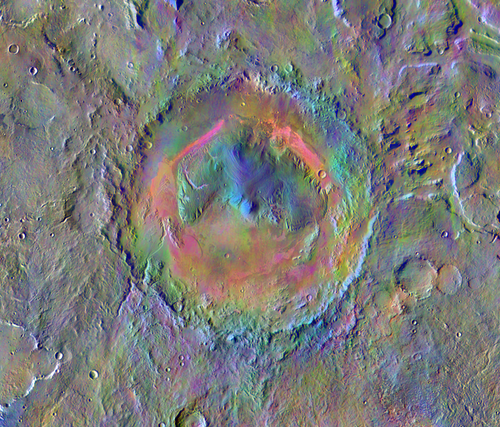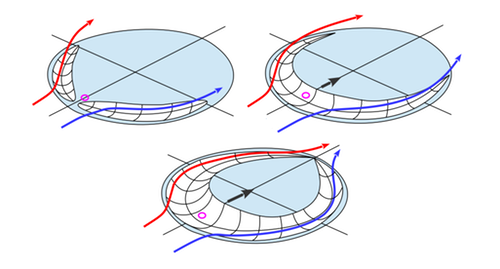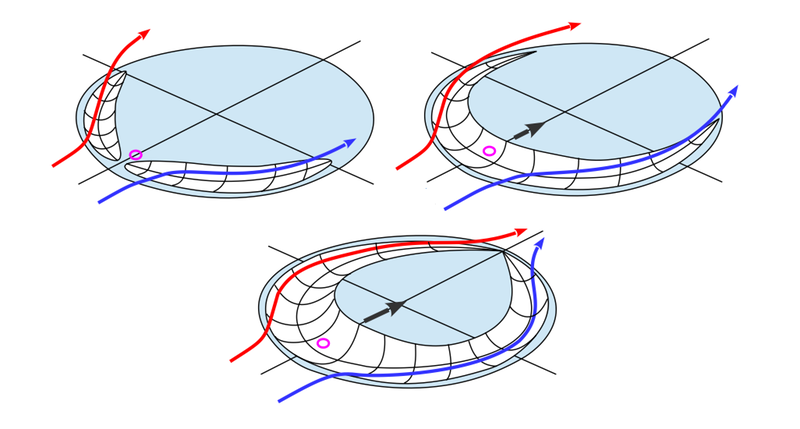Winds Can Make a Martian Mountain
The nearly 100-mile-wide Gale crater on Mars contains a 3-mile-high mountain. Now researchers have new evidence supporting one explanation for the existence of such mountains inside impact craters. Using simulations, the team showed that after the crater filled with sediment, wind vortices inside the crater’s rim could have carved out a donut-shaped region, leaving a mountain behind in the center. The simulations indicate that these winds excavate one side of a crater faster than the other, leading to an off-center mountain, which matches the topography of Gale and other Martian craters.
More than 3.7 billion years ago, a meteorite impacted Mars, creating an empty basin. So why does that basin, Gale crater, now contain a mountain? Researchers have two hypotheses, says geologist Mackenzie Day, who recently moved to the University of Washington in Seattle, but who co-authored the new study based on work at the University of Texas at Austin. In the first scenario, the mountain arises from wind eroding sediments that had earlier filled up the crater, and in the second, the topography develops from wind depositing dust and sand from outside the crater. Satellite data provide some indirect support for the first hypothesis, so Day and William Anderson, who studies fluid dynamics at the University of Texas at Dallas, wanted to test whether wind erosion could fully explain Gale crater and similar Martian craters.
In this scenario, Gale crater starts out filled, packed with rock grains left behind by wind and water flowing over Mars’ surface. Researchers believe that these sediments accumulated for about 500 million years, when Mars’ climate was still warm and wet. But things changed when the climate dried out.
Using fluid dynamics simulations that can account for turbulent winds, Day and Anderson studied the wind flow patterns over four idealized crater geometries: a filled crater, a filled crater with a shallow moat, a crater with a deep moat around the beginnings of a mountain, and an empty crater. “Real crater geometries are immensely complicated,” says Anderson. These idealized craters possess the salient geometries of Gale and similar Martian craters, but they are easier to study.
Analyzing the wind patterns directly surrounding and within the craters, the team observed a focusing of the winds by the topographic features. Small-scale vortices develop when the wind first hits the outer edge of the crater’s rim. The vortices flow over the rim into the crater and then split into two streams that propagate downwind, one stream tracking each side of the crater’s rim. As the moat deepens and lengthens, the vortices increase in strength.
Turning to whether the wind patterns could be responsible for the erosion at Gale crater, the team analyzed the properties of the vortices, finding that their strength exceeds the threshold value needed to dislodge the grains and carry them downwind. “Our results show that, over a period of a few billion years, winds alone could have removed tens of thousands of cubic kilometers of material from inside craters like Gale,” says Day.
The simulations indicate that the erosion starts at the location where the vortices enter on the upwind side of the crater. The wind initially scoops out a crescent-shaped depression that then lengthens and deepens until its two ends meet, creating a complete moat. The location where the wind first hits the crater experiences the most long-lasting erosion, so the moat at that end of the basin is widest, and the mountain is positioned downwind of the crater’s center.
The results show that wind erosion can explain the formation and position of mountains inside impact craters on Mars, says Kristen Bennett, a planetary scientist at Northern Arizona University in Flagstaff. Peter Read of the University of Oxford, who studies the dynamics of Mars’ atmosphere, agrees. He adds that having a plausible scenario for Gale crater’s evolution over the last 3 billion years will help in interpreting the geology data being collected by the rover Curiosity and in reconstructing the red planet’s geophysical history.
This research is published in Physical Review E.
–Katherine Wright
Katherine Wright is the Deputy Editor of Physics Magazine.







